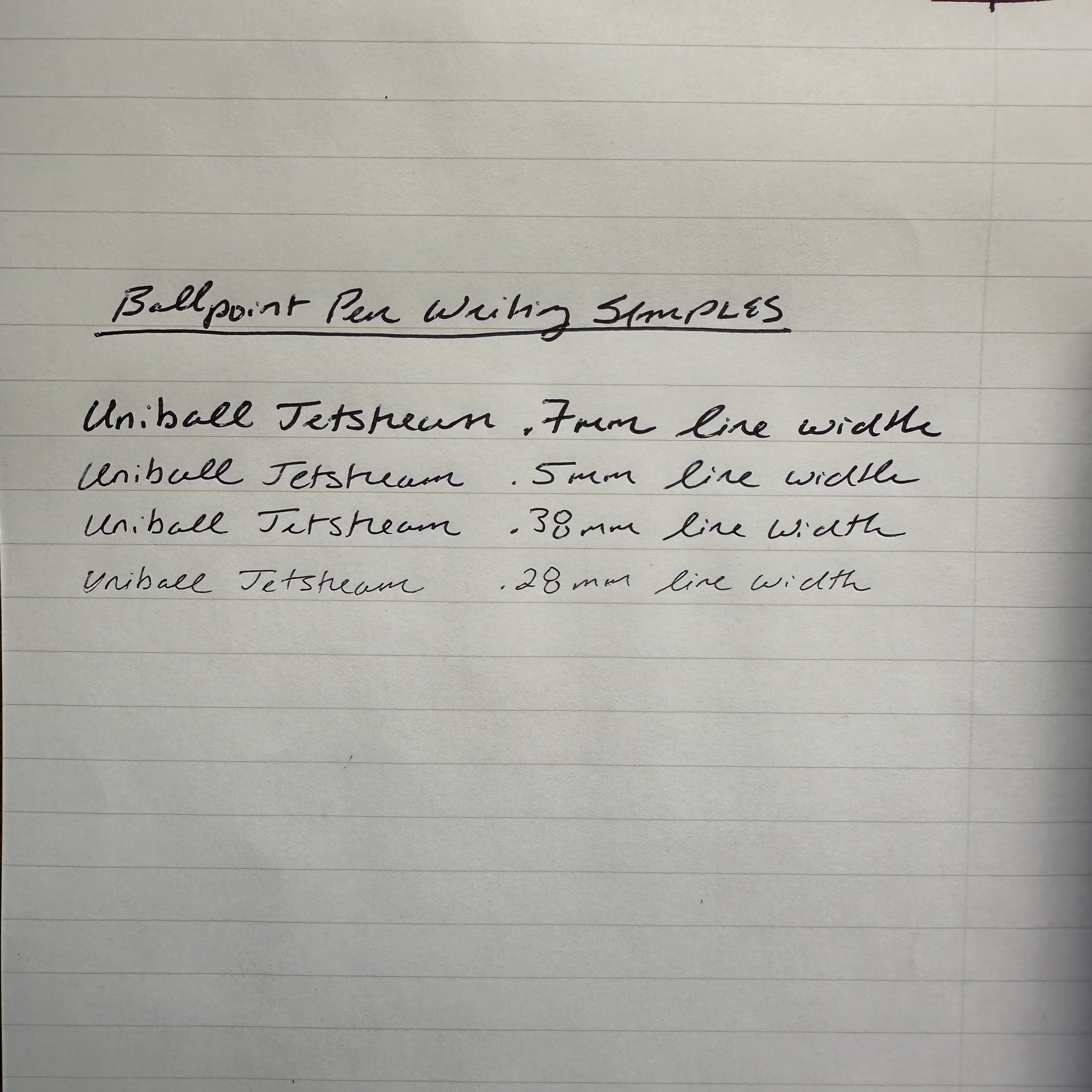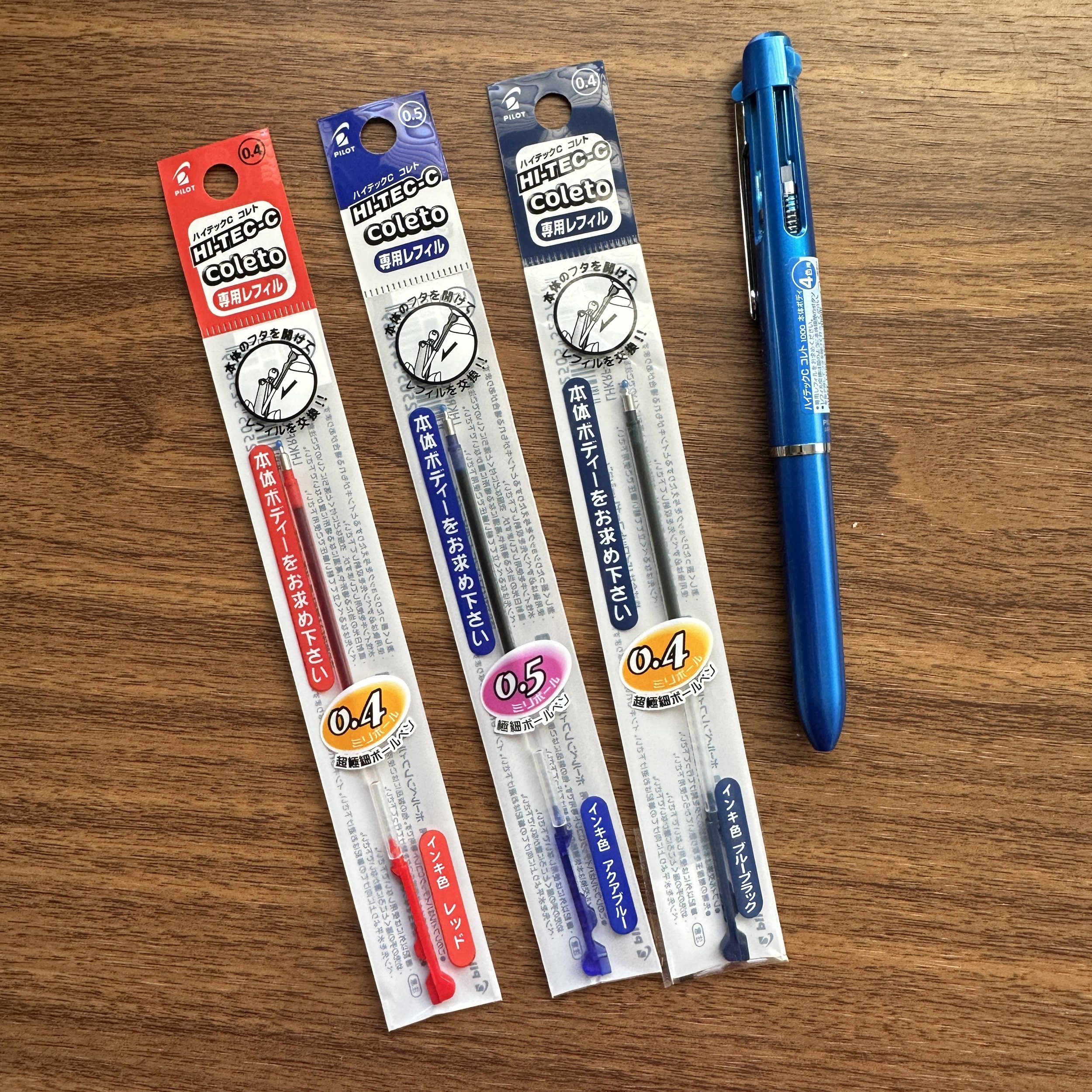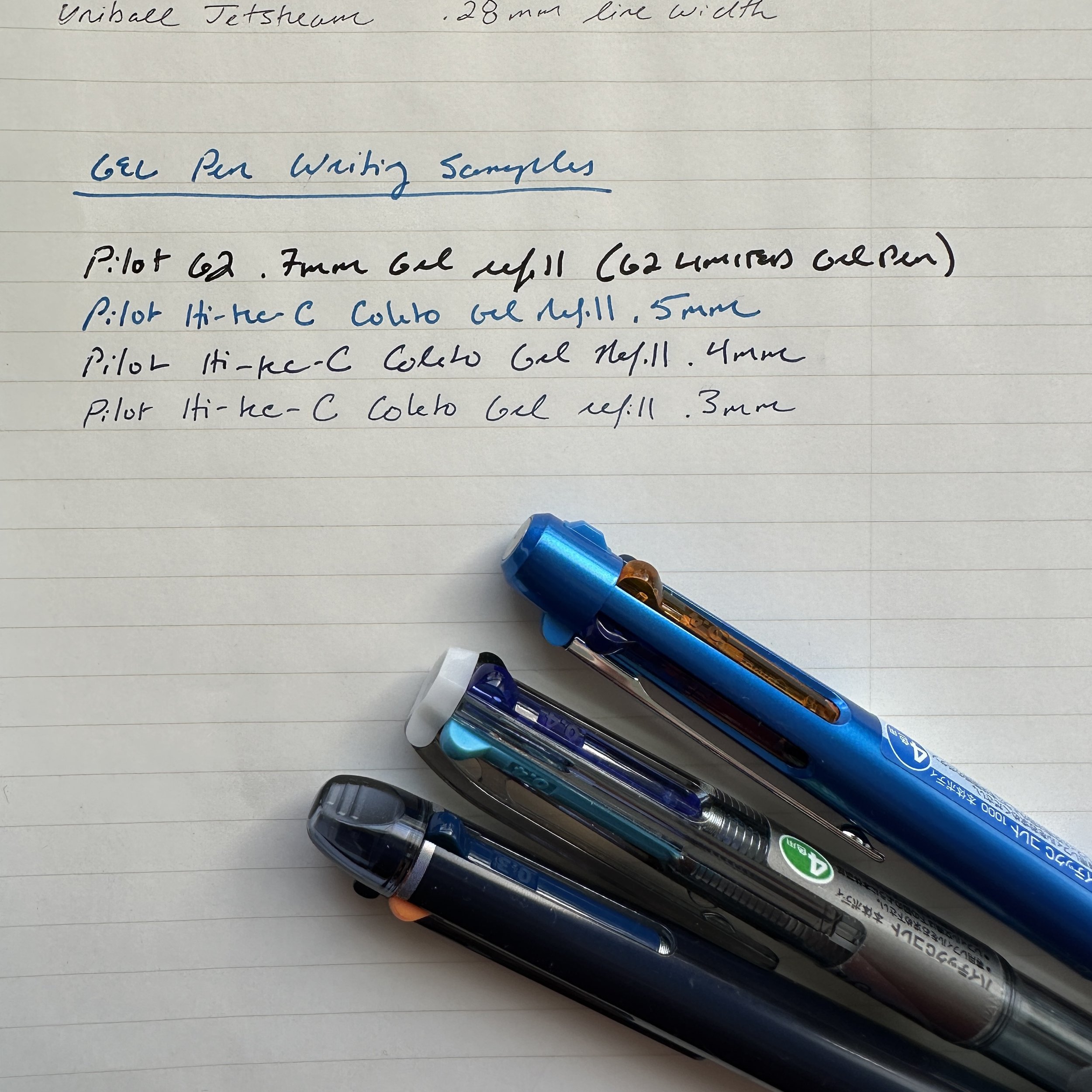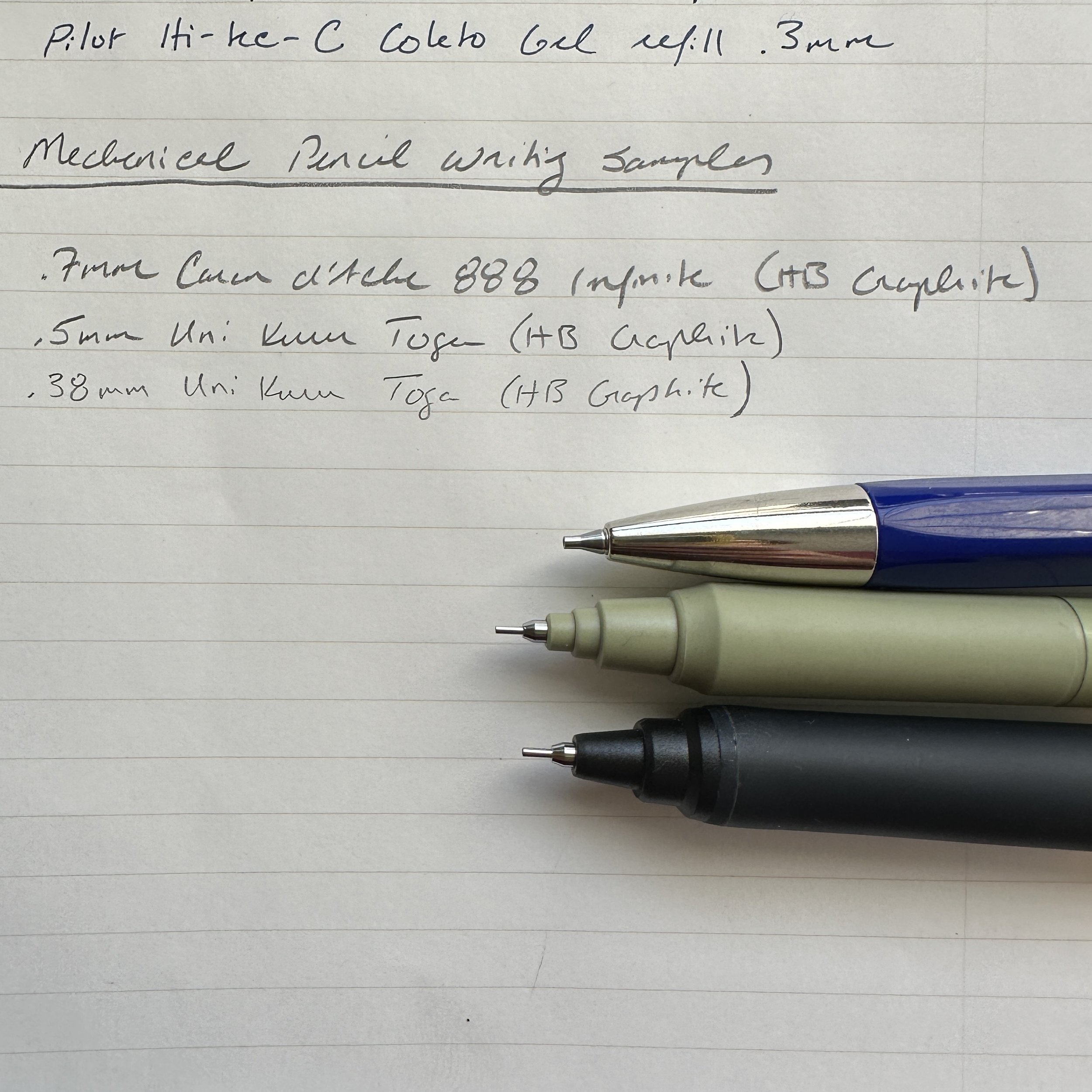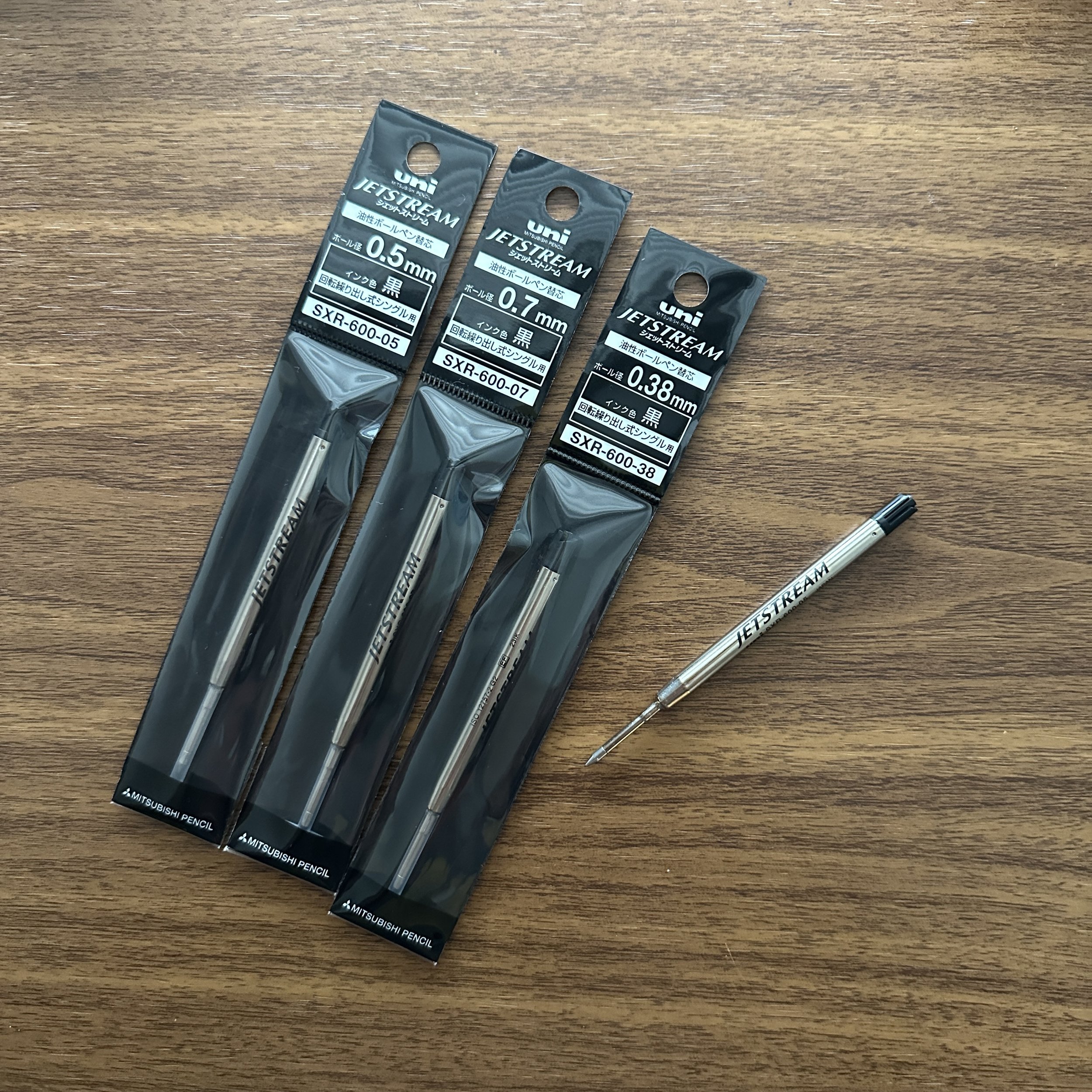It can be hard to make sense of the different tip sizes in ballpoints, gel pens, and mechanical pencils. Manufacturers tend to denote the tip size in millimeters (or tenths of a millimeter) as opposed to the arguably more descriptive "fine,” "medium,” and “broad” or “bold” typically used in fountain pens and rollerballs. Moreover, the actual corresponding line width isn't always consistent, due to differences between ballpoint and gel ink. For example, a .5mm gel pen might write a wetter line that looks wider than a corresponding .5mm ballpoint.
Since I've spent the past couple of weeks on "day job" projects that have required a lot of travel and non-fountain-pen use, I thought it might be interesting to do a direct comparison of the different widths and test some recent observations.
These days, the only ballpoint pen I use with any regularity is the Uniball Jetstream. And I use ALL the sizes. Even in non-Jetstream pens, I’ve mostly swapped out the original refill for the Parker-style Jetstream SXR-600 (shown at bottom). Shown here are the Jetstream Prime (left) and Jetstream Edge (right).
Ballpoint Example: Uniball Jetstream
It's somewhat difficult to find decent ballpoints that allow you to write a very fine line outside of Uni's Jetstream line. There are exceptions, like the Anterique Mach Ball Pens and the Ohto Refills found in Mark's and Traveler's Company Pens, but these less common Japanese imports are generally limited to the .5mm size, whereas the Jetstream comes in in both .38mm and .28mm line widths.
Since ballpoint refills are typically drier than rollerball or gel pens, you really do get a lot of differentiation between the different line widths. That .28mm can almost be described as a “hairline”, especially with light pressure.
I'm always shocked at how smooth Jetstream refills write, even at the .28mm width. .5mm will always be my personal sweet spot for everyday writing, but it's nice to have the ultra fine options for notetaking and annotation. Currently, I’m only aware of the Jetstream Edge in this ultra-fine .28mm tip, but it’s possible there are others sold in Japan.
The Pilot Hi-Tec-C Coleto has long been my go-to gel multi pen. Check out my original review from 2016!
Gel Pen Example: Pilot Hi-Tec-C Coleto Multi-Pen
The Pilot Hi-Tec-C remains a favorite gel pen, and the Coleto multi-pen version (in all of its various iterations) is probably my all-time favorite option. With gel pens, I tend to prefer the Hi-Tec-C's needle-tip, and I've found the Coleto Multi-Pen refills to resist the flow issues and clogging that can be endemic to the standard Hi-Tec-C.
I don’t have a .7m Hi-Tec-C (or know whether one even exists), so I subbed in a Pilot G2 for the .7mm writing sample.
Personally, the "sweet spot" for me is the .4mm Hi-Tec-C Coleto refill. I find these ever-so-slightly wider and smoother than most ".38mm" refills. This could be an ink issue as opposed to tip size, but I'm speaking from hands-on experience here, not any sort of technical analysis.
Mechanical Pencil Examples: Uni Kuru Toga and Caran d'Ache 888 Infinite
I've only recently begun experimenting with mechanical pencils narrower than .5mm. During my recent trip to NYC, I picked up a .38mm Uni Kuru Toga at Kinokuniya. I'm surprised at how usable this pencil is, even if you do have to be somewhat careful to avoid lead breakage. Generally speaking, a .7mm mechanical pencil will give you a line width closest to a standard woodcase pencil freshly sharpened in a long-point sharpener. The .5mm is my default “I-want-to-write-small-without-worrying-about-lead-breakage” pencil, and the size I use the most frequently. If you use a higher quality pencil lead, a .5mm mechanical pencil can be nearly as break-resistant as a .7mm pencil.
Shown here: the .7mm Caran d’Ache 888 Infinite (sorry, no longer available but the lead is identical to other Caran d’Ache Mechanical Pencils), and two Uni Kuru-Toga pencils in both .5mm and .38mm. I’m aware that .9mm and 1.1mm mechanical pencil sizes exist as well, though they’re less common and at that width, I will probably use a standard woodcase pencil or a 2mm leadholder.
Practical Considerations: Some Parting Thoughts on Choosing a Size
First, the good news: Most ballpoints, gel pens, and mechanical pencils are relatively inexpensive, so the risk of choosing the "wrong line width" is relatively low. You can buy one of each size and write with them for a while before making a larger investment in a broader range of colors or multiple refills.
If you find that you enjoy a certain brand/width combination (for example, a Jetstream in .7mm), you aren’t necessarily limited to buying pens from a single company because you can often find a more universal refill. Shown here is the Jetstream SXR-600, a Parker-style refill that fits ballpoints and rollerballs from many different brands. The Jetstream SXR-200 D1 refill is a great option for most D1 multi pens.
Second, as someone who takes a lot of notes and is a serial annotator - meaning that I obsessively mark up books, articles, and documents as I read them - I tend to find a use case for all of the different sizes. While .5mm is my go-to size for everyday writing, I typically keep a .38mm or .4mm handy, and have been experimenting with the .28mm Jetstream Edge. On the other hand, if you mainly write longhand, such as using your pens and pencils to journal, you may find .7mm the best all around choice. .5mm or wider will give you a smoother writing experience.
Here you can see an overall comparison of the three categories of writing samples above. In general, gel pens write a wider line than their corresponding ballpoint, and mechanical pencils will of course have less “spread” on the page since they don’t use liquid ink. The paper used is the Blackwing “Illegal Pad”, in the ruled format with the classic center dividing line.
Finally, though I'm still working through my thoughts on ultra-fine mechanical pencils, I'm pretty confident that anything finer than .5mm won't make it into my everyday rotation. With a mechanical pencil, you have to worry about lead breakage, and these ultra-fine widths are inescapably more fragile than their .5mm and .7mm counterparts. With a .38mm mechanical pencil, I've found that I have to pay more attention to things like paper texture, which can snag the lead and cause a break.
The Gentleman Stationer is supported entirely by purchases from the T.G.S. Curated Shop and pledges via the T.G.S. Patreon Program. Certain pens and pencils discussed in this post are available for purchase in our shop, so please consider supporting us if you enjoyed this content!


